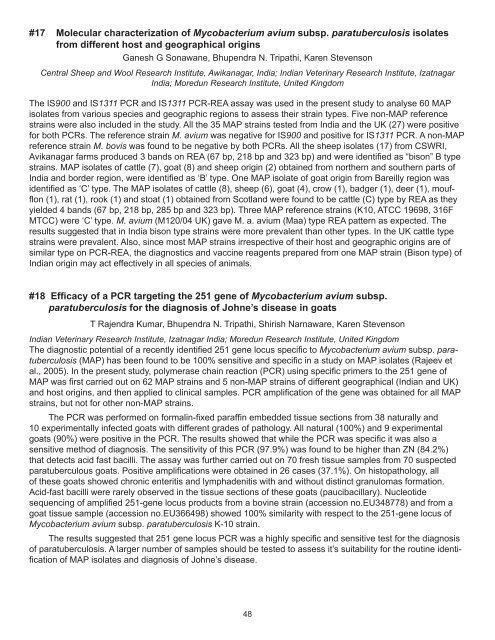Proceedings of the 10th International Colloquium on Paratuberculosis
Proceedings of the 10th International Colloquium on Paratuberculosis
Proceedings of the 10th International Colloquium on Paratuberculosis
Create successful ePaper yourself
Turn your PDF publications into a flip-book with our unique Google optimized e-Paper software.
#17 Molecular characterizati<strong>on</strong> <str<strong>on</strong>g>of</str<strong>on</strong>g> Mycobacterium avium subsp. paratuberculosis isolates<br />
from different host and geographical origins<br />
Ganesh G S<strong>on</strong>awane, Bhupendra N. Tripathi, Karen Stevens<strong>on</strong><br />
Central Sheep and Wool Research Institute, Awikanagar, India; Indian Veterinary Research Institute, Izatnagar<br />
India; Moredun Research Institute, United Kingdom<br />
The IS900 and IS1311 PCR and IS1311 PCR-REA assay was used in <str<strong>on</strong>g>the</str<strong>on</strong>g> present study to analyse 60 MAP<br />
isolates from various species and geographic regi<strong>on</strong>s to assess <str<strong>on</strong>g>the</str<strong>on</strong>g>ir strain types. Five n<strong>on</strong>-MAP reference<br />
strains were also included in <str<strong>on</strong>g>the</str<strong>on</strong>g> study. All <str<strong>on</strong>g>the</str<strong>on</strong>g> 35 MAP strains tested from India and <str<strong>on</strong>g>the</str<strong>on</strong>g> UK (27) were positive<br />
for both PCRs. The reference strain M. avium was negative for IS900 and positive for IS1311 PCR. A n<strong>on</strong>-MAP<br />
reference strain M. bovis was found to be negative by both PCRs. All <str<strong>on</strong>g>the</str<strong>on</strong>g> sheep isolates (17) from CSWRI,<br />
Avikanagar farms produced 3 bands <strong>on</strong> REA (67 bp, 218 bp and 323 bp) and were identified as “bis<strong>on</strong>” B type<br />
strains. MAP isolates <str<strong>on</strong>g>of</str<strong>on</strong>g> cattle (7), goat (8) and sheep origin (2) obtained from nor<str<strong>on</strong>g>the</str<strong>on</strong>g>rn and sou<str<strong>on</strong>g>the</str<strong>on</strong>g>rn parts <str<strong>on</strong>g>of</str<strong>on</strong>g><br />
India and border regi<strong>on</strong>, were identified as ‘B’ type. One MAP isolate <str<strong>on</strong>g>of</str<strong>on</strong>g> goat origin from Bareilly regi<strong>on</strong> was<br />
identified as ‘C’ type. The MAP isolates <str<strong>on</strong>g>of</str<strong>on</strong>g> cattle (8), sheep (6), goat (4), crow (1), badger (1), deer (1), mouffl<strong>on</strong><br />
(1), rat (1), rook (1) and stoat (1) obtained from Scotland were found to be cattle (C) type by REA as <str<strong>on</strong>g>the</str<strong>on</strong>g>y<br />
yielded 4 bands (67 bp, 218 bp, 285 bp and 323 bp). Three MAP reference strains (K10, ATCC 19698, 316F<br />
MTCC) were ‘C’ type. M. avium (M120/04 UK) gave M. a. avium (Maa) type REA pattern as expected. The<br />
results suggested that in India bis<strong>on</strong> type strains were more prevalent than o<str<strong>on</strong>g>the</str<strong>on</strong>g>r types. In <str<strong>on</strong>g>the</str<strong>on</strong>g> UK cattle type<br />
strains were prevalent. Also, since most MAP strains irrespective <str<strong>on</strong>g>of</str<strong>on</strong>g> <str<strong>on</strong>g>the</str<strong>on</strong>g>ir host and geographic origins are <str<strong>on</strong>g>of</str<strong>on</strong>g><br />
similar type <strong>on</strong> PCR-REA, <str<strong>on</strong>g>the</str<strong>on</strong>g> diagnostics and vaccine reagents prepared from <strong>on</strong>e MAP strain (Bis<strong>on</strong> type) <str<strong>on</strong>g>of</str<strong>on</strong>g><br />
Indian origin may act effectively in all species <str<strong>on</strong>g>of</str<strong>on</strong>g> animals.<br />
#18 Efficacy <str<strong>on</strong>g>of</str<strong>on</strong>g> a PCR targeting <str<strong>on</strong>g>the</str<strong>on</strong>g> 251 gene <str<strong>on</strong>g>of</str<strong>on</strong>g> Mycobacterium avium subsp.<br />
paratuberculosis for <str<strong>on</strong>g>the</str<strong>on</strong>g> diagnosis <str<strong>on</strong>g>of</str<strong>on</strong>g> Johne’s disease in goats<br />
T Rajendra Kumar, Bhupendra N. Tripathi, Shirish Narnaware, Karen Stevens<strong>on</strong><br />
Indian Veterinary Research Institute, Izatnagar India; Moredun Research Institute, United Kingdom<br />
The diagnostic potential <str<strong>on</strong>g>of</str<strong>on</strong>g> a recently identified 251 gene locus specific to Mycobacterium avium subsp. paratuberculosis<br />
(MAP) has been found to be 100% sensitive and specific in a study <strong>on</strong> MAP isolates (Rajeev et<br />
al., 2005). In <str<strong>on</strong>g>the</str<strong>on</strong>g> present study, polymerase chain reacti<strong>on</strong> (PCR) using specific primers to <str<strong>on</strong>g>the</str<strong>on</strong>g> 251 gene <str<strong>on</strong>g>of</str<strong>on</strong>g><br />
MAP was first carried out <strong>on</strong> 62 MAP strains and 5 n<strong>on</strong>-MAP strains <str<strong>on</strong>g>of</str<strong>on</strong>g> different geographical (Indian and UK)<br />
and host origins, and <str<strong>on</strong>g>the</str<strong>on</strong>g>n applied to clinical samples. PCR amplificati<strong>on</strong> <str<strong>on</strong>g>of</str<strong>on</strong>g> <str<strong>on</strong>g>the</str<strong>on</strong>g> gene was obtained for all MAP<br />
strains, but not for o<str<strong>on</strong>g>the</str<strong>on</strong>g>r n<strong>on</strong>-MAP strains.<br />
The PCR was performed <strong>on</strong> formalin-fixed paraffin embedded tissue secti<strong>on</strong>s from 38 naturally and<br />
10 experimentally infected goats with different grades <str<strong>on</strong>g>of</str<strong>on</strong>g> pathology. All natural (100%) and 9 experimental<br />
goats (90%) were positive in <str<strong>on</strong>g>the</str<strong>on</strong>g> PCR. The results showed that while <str<strong>on</strong>g>the</str<strong>on</strong>g> PCR was specific it was also a<br />
sensitive method <str<strong>on</strong>g>of</str<strong>on</strong>g> diagnosis. The sensitivity <str<strong>on</strong>g>of</str<strong>on</strong>g> this PCR (97.9%) was found to be higher than ZN (84.2%)<br />
that detects acid fast bacilli. The assay was fur<str<strong>on</strong>g>the</str<strong>on</strong>g>r carried out <strong>on</strong> 70 fresh tissue samples from 70 suspected<br />
paratuberculous goats. Positive amplificati<strong>on</strong>s were obtained in 26 cases (37.1%). On histopathology, all<br />
<str<strong>on</strong>g>of</str<strong>on</strong>g> <str<strong>on</strong>g>the</str<strong>on</strong>g>se goats showed chr<strong>on</strong>ic enteritis and lymphadenitis with and without distinct granulomas formati<strong>on</strong>.<br />
Acid-fast bacilli were rarely observed in <str<strong>on</strong>g>the</str<strong>on</strong>g> tissue secti<strong>on</strong>s <str<strong>on</strong>g>of</str<strong>on</strong>g> <str<strong>on</strong>g>the</str<strong>on</strong>g>se goats (paucibacillary). Nucleotide<br />
sequencing <str<strong>on</strong>g>of</str<strong>on</strong>g> amplified 251-gene locus products from a bovine strain (accessi<strong>on</strong> no.EU348778) and from a<br />
goat tissue sample (accessi<strong>on</strong> no.EU366498) showed 100% similarity with respect to <str<strong>on</strong>g>the</str<strong>on</strong>g> 251-gene locus <str<strong>on</strong>g>of</str<strong>on</strong>g><br />
Mycobacterium avium subsp. paratuberculosis K-10 strain.<br />
The results suggested that 251 gene locus PCR was a highly specific and sensitive test for <str<strong>on</strong>g>the</str<strong>on</strong>g> diagnosis<br />
<str<strong>on</strong>g>of</str<strong>on</strong>g> paratuberculosis. A larger number <str<strong>on</strong>g>of</str<strong>on</strong>g> samples should be tested to assess it’s suitability for <str<strong>on</strong>g>the</str<strong>on</strong>g> routine identificati<strong>on</strong><br />
<str<strong>on</strong>g>of</str<strong>on</strong>g> MAP isolates and diagnosis <str<strong>on</strong>g>of</str<strong>on</strong>g> Johne’s disease.<br />
48






